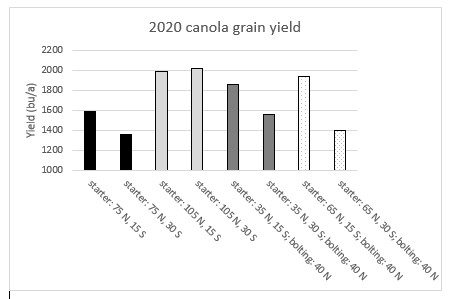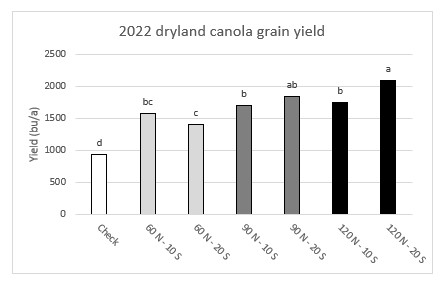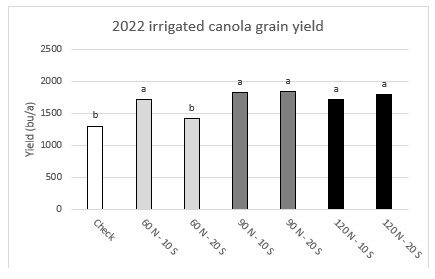Like most other crops, canola needs nitrogen to maximize its yield, but it is also very responsive to sulfur fertilization. There are about 2 lbs of nitrogen and 0.2 lbs of sulfur in a bushel of canola seed. The ratio of nitrogen to sulfur in the seed is known to affect oil content and quality. The ratio of available nitrogen to available sulfur in the soil is known to affect nitrogen use efficiency especially at higher rates of nitrogen. However, the availability of nitrogen could also affect sulfur use efficiency. The North Dakota recommendation is 150 lbs of available nitrogen coming from a combination of soil nitrates and fertilizer nitrogen for canola. For sulfur the recommendation is to apply 20 lbs of sulfur in a sulfate form on heavier soil and 30 lbs on lighter soil irrespective of soil test, because soil test sulfur is not a reliable predictor of sulfur yield response. Therefore, recommended sulfur is a flat rate while the nitrogen rate applied varies with soil test nitrogen levels. This means that, even while following recommendations, the ratio of sulfur to nitrogen applied can vary from year to year. Most of the time, this is not a problem, but in some cases, there is only a low amount of residual nitrogen in the immediate vicinity of the seedlings, even though the soil test levels for the 0-6 inches are high. In that instance the ratio of available sulfur to available nitrogen can be higher than intended, which can lower yield.
At the CREC we had studies, partially funded by the Northern Canola Growers Association, in which nitrogen and sulfur were applied at different rate combinations. The studies were initially intended to focus on nitrogen rates, but there were noteworthy results involving sulfur rates.
In the 2020 trial year, besides fertilizer rates, timing of application was also a factor. In 2022, all the fertilizer was applied at planting. In 2021, the trials were severely affected by drought, therefore data from that year is excluded.
In the 2020 study there were two nitrogen rates (75 and 105 lbs/a) that were either applied at planting or as a split application. Based on soil test, the total amount of available nitrogen at the 105 lb N rate was 150 lbs and 120 at the 75 lb N rate. In the split-applied nitrogen treatments, 40 lbs of nitrogen was applied at bolting, and starter was applied at either 35 or 65 lbs N. Each of the nitrogen treatments were also fertilized with either 15 or 30 lbs of sulfur at planting (Table 1).
|
Table 1. Treatment structure in 2020.
|
|
Trt #
|
Starter fertilizer
|
fertilizer applied at bolting
|
|
1
|
75 lbs N, 15 lbs S
|
|
|
2
|
75 lbs N, 30 lbs S
|
|
|
3
|
105 lbs N, 15 lbs S
|
|
|
4
|
105 lbs N, 30 lbs S
|
|
|
5
|
35 lbs N, 15 lbs S
|
40 lbs N
|
|
6
|
35 lbs N, 30 lbs S
|
40 lbs N
|
|
7
|
65 lbs N, 15 lbs S
|
40 lbs N
|
|
8
|
65 lbs N, 30 lbs S
|
40 lbs N
|
While yields were not significantly different from each other, yields with the higher rate of sulfur applied at planting were lower in all but the highest rate of starter nitrogen. (Figure 1.)
Figure 1. 2020 canola grain yields in response to fertilizer treatments applied at planting and at bolting.
In 2022, the trial was replicated under irrigation and on dryland. There were three nitrogen rates (60, 90 and 120 lbs/a), all applied at planting, with two rates of sulfur, also applied at planting (Table 2). At the dryland site residual soil nitrogen was 27 lbs/a. Under irrigation it was 15.
|
Table 2. Treatment structure in 2022.
|
|
Trt #
|
N-rate applied (lbs/a)
|
S-rate applied
(lbs/a)
|
|
1
|
0
|
0
|
|
3
|
60
|
10
|
|
4
|
60
|
20
|
|
5
|
90
|
10
|
|
6
|
90
|
20
|
|
7
|
120
|
10
|
|
8
|
120
|
20
|
At the lowest rate of nitrogen (60 lbs N/a), the higher rate of sulfur (20 lbs S), produced a lower yield at both trial sites (Figures 2 and 3).
Figure 2. 2022 dryland canola grain yield in response to starter applied fertilizer treatments.
Figure 3. 2022 irrigated canola grain yield in response to starter applied fertilizer treatments.
Discussion
At all three trial sites, the higher rate of sulfur was detrimental to canola yields when nitrogen was applied at 75 lbs or less, regardless of residual soil nitrogen levels. Because there were only two sulfur rates in each of the studies, the maximum beneficial rate of sulfur at each nitrogen rate and where yields would have started declining could not be determined. Additionally, timing mattered. When the full rate of nitrogen was applied as a starter at 105 lbs N, the additional sulfur did not decrease yield, but when the same nitrogen rate was split, yields were lower with the higher rate of sulfur (Figure 1). This is likely because the ratio of available sulfur to nitrogen was high initially, even though the plots received more nitrogen later in the season. Interaction effects on yield between nitrogen and sulfur fertilizer rates seemed to be limited to rates that were applied at the same time.
It seems that though sulfur improves nitrogen use efficiency of canola up to a point, a rate that is too high in relation to the nitrogen rate can lower yields.



